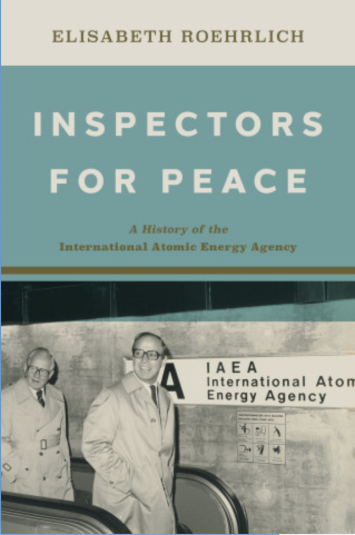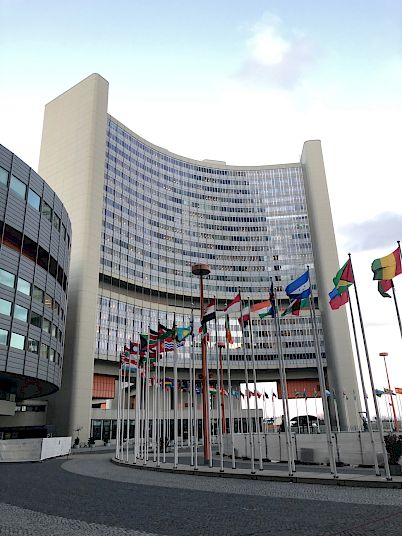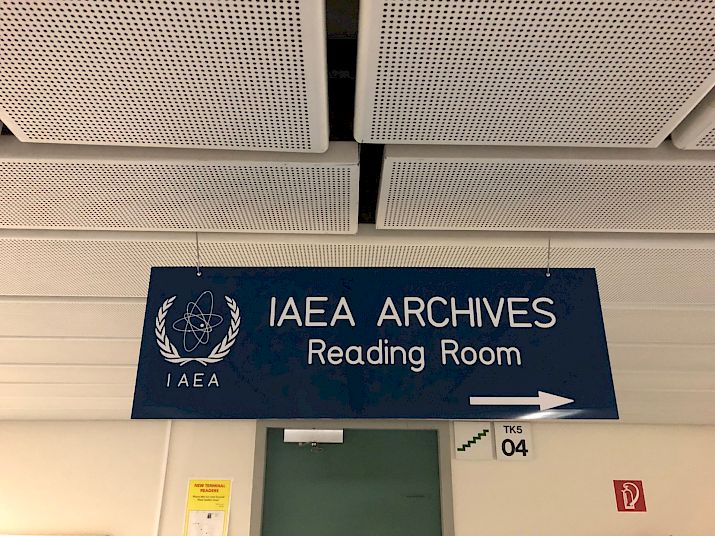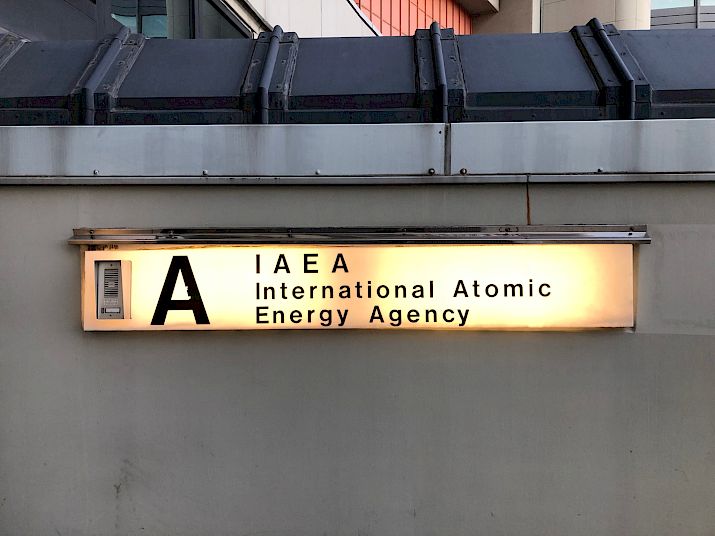Review: Inspectors for Peace by Elisabeth Roehrlich
Elisabeth Roehrlich, Inspectors for Peace: A History of the International Atomic Energy Agency (Johns Hopkins University Press, 2022)
Review by Marc Reyes, University of Connecticut.

On the morning of May 18, 1974, Dimitri Perricos noticed an unusual number of smirking faces at his hotel. Perricos, one of two International Atomic Energy Agency (IAEA) inspectors visiting India, thought he and his colleague’s presence had generated an unusual amount of excitement from hotel staff and other guests. Curious as to why two international bureaucrats had elicited such a lively reaction, Perricos asked around until he saw the front pages of several Indian newspapers. When Perricos had arrived in India, on the evening of May 17, his host country had never tested a nuclear device. But as night became day, India kept a tryst with nuclear destiny. It is one thing to be present at the creation, it is another thing to sleep through it. While the IAEA officials were sleeping, the Indian Army tested a nuclear fission device in the Rajasthani desert. To state the obvious: nuclear explosions are not everyday events so one happening during an atomic inspection tour sounds like a once-in-a-lifetime event — or the beginning of a joke.
To counter, here is a not-so-obvious statement: it is an interesting time to be a scholar of nuclear history. Impressive books such as Jayita Sarkar’s Ploughshares and Swords (2022) and Vipin Narang’s Seeking the Bomb (2022) are works that scholars of the nuclear past and present will be poring over for years, if not decades. But even outside academia, atomic power and its potential to destroy captures audiences’ attention in a way few phenomena do. The television miniseries Chernobyl (2019) and the 2023 Academy Award winner for Best Picture, Oppenheimer, reveal that nuclear power plays to both our fears and entertainment. How else can we explain the critical and financial success of a three-hour movie about a physicist? In the nearly eight decades since J. Robert Oppenheimer oversaw the Trinity nuclear test in the New Mexico desert, the terror and the promise of nuclear power have occupied space not just in the minds of Americans, but of all people.
Even before the United States dropped its bombs on Hiroshima and Nagasaki, it was already looking over its atomic shoulder to see who else might join the ultra-elite club of nuclear weapon states. As long as there have been efforts to share the benefits of nuclear power, there also have been attempts to stop its spread or limit it only to friends and allies. Once a nation obtains bomb power, it seeks to deny others the same ability and preserve the nuclear status quo. But restricting something only makes some nations want it more, especially with atomic bombs’ reputation as the ultimate weapon of war. As states struggled with promoting atomic power and its many uses while also regulating and curtailing many of those uses, a new body was needed to handle such contradictions.

Out front of the Vienna International Centre (VIC), headquarters of the International Atomic Energy Agency (IAEA). Photo provided by the author.
At the core of historian Elisabeth Roehrlich’s excellent book, the first comprehensive and independent study of the IAEA, is the agency’s dual mandate to both share “nuclear materials, technology, and knowledge while aiming to deter nuclear weapon programs” (3). Making this feat even more difficult, if not impossible, is that the IAEA has no instruments to stop rogue nuclear powers or authority to punish atomic offenders. Roehrlich’s Inspectors for Peace: A History of the International Atomic Energy Agency (2022) wrestles with the mandate while never shying away from two inconvenient truths: states that have benefitted from atomic technical assistance are more likely to pursue nuclear weapon programs, and disseminating knowledge of nuclear technology also spreads the ability to make nuclear bombs (3). By undertaking the first half of its mandate, the IAEA makes it tough to achieve the second half.
Early on, because Roehrlich has produced the first independent monograph-length investigation of the IAEA, she takes her time explaining what the book is and what it is not. Inspectors for Peace is not “a meticulous history” but instead examines crucial moments and key decisions made during the agency’s nearly seventy years of operation. Some of the leading figures are the agency’s different directors-general as well as the IAEA’s two policy-making organs: the Board of Governors and the larger General Conference made up of delegates from member states. Roehrlich’s book is a study of global governance and how international organizations, especially after World War II, have played a role and contributed to the postwar global order. A vital question that Roehrlich poses early, but which readers will see carried throughout the work, is that with two distinct mandates, and seeming contradictions, is: why didn’t the IAEA fail (5-12)? I think this question needs to be asked, but it also leads to an even more important one that will be discussed later.
Unfolding over nine chapters, plus an introduction and conclusion, Inspectors for Peace is structured into three distinct parts. Chapters 1-3 examine the prehistory of the IAEA and how it emerged out of the failed United Nations Atomic Energy Commission. Roehrlich wisely pointed out that voluntary cooperation on arms control and disarmament is a relatively new development. For most of human history, disarmament has come not by choice but after defeat. Furthermore, there was no precedent for regulating or prohibiting a particular form of energy production (20-22). Despite atomic anxieties, especially once the Soviet Union obtained its bomb in 1949, there were green shoots for potential nuclear diplomacy, most notably with President Eisenhower’s Atoms for Peace initiative. By January 1954, the U.S. and U.S.S.R. were quietly exchanging views about how to store fissionable material and share such resources for civilian and peaceful purposes. Even the choice of the IAEA’s headquarters, Vienna, was the work of careful negotiations between the great powers. Roehrlich reminds readers that even as the world wrestled with the Suez and Hungary crises in 1956, it still managed to work together and successfully found an organization devoted to atomic issues (58-60). By summer 1957, the IAEA had gone from idea to reality.
The book’s second part, chapters four through six, is the strongest, with Roehrlich skillfully showing the fundamental tensions within the IAEA’s work. For starters, many nations, especially ones in the Global South, were interested in the IAEA because of its promise to provide technical assistance. Developing nations as well as those emerging from colonialism relished the idea of more prosperous states providing reactors, isotopes, scientists, fellowships, and other resources to help newer countries get on their nuclear feet. In an era when policymakers imagined nuclear power “too cheap to meter” and an endless abundance of clean and safe energy, atomic power seemed like the key ingredient for a nation’s industrial development. But there was a catch: by the 1960s, the dominant states in the IAEA – especially Board of Governors members like the U.S. and the U.S.S.R. – began talking about safeguards as much as technical assistance. It became apparent to IAEA members that strings were attached. IAEA staff and leadership had to cajole states into safeguards agreements as well as translate them into legal and technical terms. And then the IAEA had to ensure that states honored them. How this came to a head is examined in Roehrlich’s standout chapter on the Nuclear Non-Proliferation Treaty. As Roehrlich emphasizes, “The agency’s founders had neither envisioned, nor explicitly excluded, a global nonproliferation mandate for the IAEA” (108). Since 1945, nations had called for disarmament and the abolition of nuclear weapons, but by 1963, what would become the defining agreement governing nuclear proliferation began in earnest, but not at IAEA’s Vienna headquarters. Instead, Geneva played host to the negotiations of the Eighteen-Nation Committee on Disarmament that shaped the nuclear proliferation treaty, taking it from concept to full draft in five years. Bizarrely, the IAEA would have new responsibilities under the treaty and to ensure it was being followed, but it had no role in writing it because of the treaty’s political nature. As will be explained later, Roehrlich’s book never shies away from the IAEA’s phobia of being seen as a political body instead of a merely technical one. The agency’s aloofness and above-the-fray mentality have both worked for and weakened the IAEA.
Chapters seven through nine, Inspectors for Peace’s final three chapters, jump in time, through the 1970s and carry the story to modern day. Even as the chapters examined different moments in nuclear history, a clear key theme is the IAEA’s struggles as a nuclear watchdog. To many, the IAEA is supposed to be the nuclear cop on the nuclear beat, but by design, it cannot make or force any nation, including a nuclear bad actor, do anything. When a nation conducted a secret test or unauthorized strike on another nation’s nuclear reactor, the IAEA was left twiddling its thumbs because it has neither the power nor the personnel to stop a state, member or otherwise. Roehrlich’s chapter on the Chernobyl disaster — a reactor explosion at the V.I. Lenin Nuclear Power Plant in northern Ukraine — is especially enlightening as the IAEA did not know about the explosion until three days after it had happened. As the world waited for concrete news, the IAEA too was in the dark, waiting for Soviet officials to muster any transparency or truth about what happened. While Soviet leader Mikhail Gorbachev proposed political glasnost (openness), he and other Soviet leaders were not in favor of any nuclear glasnost, and the IAEA found itself a reluctant messenger of Chernobyl. Cleaning up Chernobyl took years, and the IAEA’s job became even tougher once the U.S.S.R. dissolved.

A sign directing researchers toward the IAEA Archives Reading Room. Photo provided by the author.
Besides its wide review of nuclear history literature, Roehrlich’s book also shines light on the IAEA sources her work incorporated. The author has made impressive use of IAEA records, from General Conference and Board of Governors meeting minutes to staff oral histories to interviews with IAEA directors-general. As someone who has conducted research in Vienna and been fortunate to work in the IAEA Archives, I was heartened to see a work constructed on IAEA sources. I was particularly delighted to see Roehrlich mention IAEA Archive staff by name including an archivist I had the pleasure of working with, whose guidance helped me better see the global focus of my dissertation. Roehrlich also includes a handy glossary of nuclear terms for the uninitiated who may be wary of a topic so laden with dense terms and jargon. While the subject may be dry and technical, the writing is not. Roehrlich’s prose is clear and commanding, engaging and explicit.
Even as Roehrlich’s book succeeds in many ways, a few critiques are in order. First, while the author is clear that her book is not “the” history but rather “a” history of the IAEA, it is not always clear, especially the last three chapters, why she has chosen to analyze these particular moments in IAEA history. If the goal was to focus on times when the IAEA’s dual mandate was most exposed as a fallacy, I suspect there are more than the nine moments elaborated in the book’s main chapters. Second, while Inspectors for Peace succeeds in showcasing the perspectives of other IAEA member states, especially those in the Global South, like India, always looming in the background is how the IAEA functioned as a result of both great power competition and, eventually, great power collaboration— even at times, great power collusion as the U.S. and U.S.S.R. produced identical non-proliferation treaty drafts and presented them to other member states as a fait accompli. More about the great power politics at play throughout the book would have made a strong book even stronger. Roehrlich does mention the Soviets’ change-of-heart on safeguards in the early 1960s, but more is needed, especially a wider view of Soviet politics and relationships, to better understand how and why the Soviets went from fearing safeguards to learning to love them.
In her book’s introduction, Elisabeth Roehrlich states, that “Common sense would suggest that an international organization with contradictory missions and domination by two opposing powers is doomed to fail” (5). She then posits that the IAEA thrived throughout the Cold War and the shock of its end. Reading her book, though, maybe the question is why didn’t the IAEA fail, but why it was successful? Roehrlich’s nine chapters depict a hamstrung organization, intentionally designed to never hold the atomic powers accountable but to preserve great power status quo. Despite laws and treaties and presumed consequences, the IAEA is often unable to respond to crises that require a body like it to solve. Like the United Nations when war breaks out or the World Health Organization when a possible pandemic nears, the IAEA is unable to do more than act as coordinator, not leader or dominant actor. International organizations like these strive to appear as democratic bodies, but not too democratic lest the current global powers be unable to shape the agenda. The IAEA may have survived the Cold War, but few would call it thriving. As the world endures a new nuclear age, with North Korean, Iranian, and possible Saudi Arabian atomic bombs, what will the IAEA do? The answer, however, depends more on whatever the great powers want.
Further feeding into the problem is the agency’s self-image as solely a technical, not a political, one. Roehrlich makes clear that this framing has been popular with the IAEA since its founding, helping to perpetuate the thinking that science and technology are apolitical concepts instead of ones involving conscious choices. For the IAEA, being seen as political is to be feared, and this gets in the way of their doing their job or doing it right. As Roehrlich succinctly puts it, “Calling something “political” was often just another way of saying ‘I don’t agree’” (85). Promotion of milquetoast polices led to nonproliferation instead of disarmament or abolition. Rather than holding the U.S.S.R. accountable for years of safety problems at V.I. Lenin Nuclear Power Plant, the IAEA had to accept Soviet silence as Gorbachev and other leaders downplayed and outright ignored the disaster in front of them. Will the IAEA ever be unshackled from its great power benefactors and become a genuine nuclear watchdog? Will it finally be the nuclear cop on the nuclear beat, dispensing justice? There has never been a better time to find out.

Sign outside the main entrance of the IAEA. Photo provided by the author.